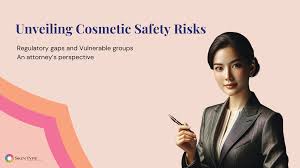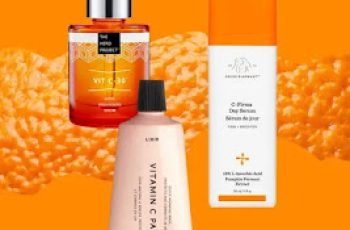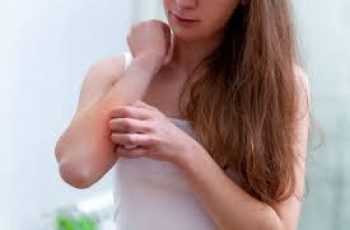
Unveiling Cosmetic Safety Risks: Regulatory Gaps and Vulnerable Groups
Unveiling Cosmetic Safety Risks: Regulatory Gaps and Vulnerable Groups
The complex world of cosmetic safety, where the allure of beauty products conceals a potential hazard: companies can incorporate a myriad of ingredients, and the Food and Drug Administration (FDA) has limited authority to intervene.[1] This regulatory gap raises concerns about the safety of cosmetic products, particularly for vulnerable groups such as pregnant women, children, economically at-risk individuals, those residing in geographically at-risk areas, individuals with limited English proficiency, and different racial groups. These populations may be more susceptible to the adverse effects of certain chemicals found in cosmetics. In this article, we delve into the inherent dangers of unrestricted cosmetic formulation and explore how the introduction of the MoCRA (The Modernization of Cosmetics Regulation Act) can transform the regulatory landscape, offering a solution to ensure the safety of cosmetics for all, with a particular emphasis on protecting the well-being of these vulnerable groups.[2]
Before you buy any skin care products, it is important to know your Baumann Skin Type so you can make informed decisions based on science, preferences, and budget.
Nurturing Life: Safeguarding Maternal Wellness through Thoughtful Cosmetic Choices
Pregnancy, a time of heightened sensitivity, requires a meticulous approach to cosmetic choices. According to the American College of Obstetricians and Gynecologists (ACOG), personal care products may contain environmental contaminants that can have lasting effects on reproductive health, emphasizing the need to avoid certain chemicals.[3]Among these, aluminum, beta hydroxy acids (BHA), diethanolamine (DEA), and others pose specific risks. While aluminum is a known neurotoxin, BHAs, like salicylic acid, can lead to embryo malformation.[4] DEA, commonly found in hair and body products, has been linked to alterations in sperm structure. These findings underscore the importance of scrutinizing ingredient lists to minimize exposure during this critical period.
children
Guardians of Innocence: Navigating the Delicate World of Children and Cosmetics
Children, owing to their distinctive vulnerabilities, demand meticulous consideration when engaging with cosmetics. Their petite body size, developing organs, and nascent immune systems render them inherently more susceptible to the harmful effects of toxicants. Numerous studies underscore the prevalence of neurodevelopmental concerns and ingestion hazards linked to children’s makeup and body products.[5] A particularly alarming revelation emerged in 2019 when Claire’s, a popular retailer targeting young girls, voluntarily recalled a makeup set[6]. This decision followed the detection of asbestos by the Food and Drug Administration, a substance that poses severe health risks. Such incidents underscore the critical importance of stringent regulatory measures and heightened consumer awareness to shield our young ones from potential harm in the realm of cosmetics.
racial disparities
Racial Disparities in Cosmetic Chemical Exposure
Personal care products exhibit a multitude of variations, dictated not only by their intended purpose but also by the target demographic.[7] Take hair products, for instance—their formulations diverge significantly based on the type of hair they are designed for, thereby contributing to exacerbated exposure and disease disparities, particularly across different racial groups. Black women, in particular, encounter potential exposure to an array of hazardous chemicals through the use of hair products, many of which are identified as endocrine disruptors—substances that disrupt the body’s hormonal balance, including estrogen.[8]
Recent comprehensive studies delving into chemical exposure disparities among 38,080 U.S. women unearth disturbing racial inequities. Non-Hispanic Black, Mexican American, Other Hispanic, and Other Race/Multi-Racial women confront disproportionate exposure to a cocktail of harmful agents, spanning pesticides, parabens, metals, and more.[9] These disparities persist consistently across various life stages, underscoring an immediate need for targeted interventions to address this systemic issue. A specialized study focusing on women of color intensifies the gravity of the situation, highlighting that a staggering 65% of product labels within this demographic include warnings related to cancer, reproductive harm, or endocrine-disrupting agents. These revelations starkly underscore the urgency for regulatory measures that rectify the disproportionate impact of cosmetic chemicals on specific demographic groups, advocating for a more equitable and health-conscious landscape in the realm of personal care products.
economically at risk
Economically at-risk individuals
Economically at-risk individuals face a distinct set of challenges when it comes to cosmetic safety. Limited financial resources may hinder their access to safer or higher-quality cosmetic products, compelling them to opt for more affordable alternatives that often contain potentially harmful ingredients. The economic constraints these individuals encounter create a scenario where compromised product choices could result in increased exposure to harmful chemicals. The intersection of economic vulnerability and cosmetic safety underscores the importance of addressing affordability concerns in the beauty industry. Initiatives aimed at promoting accessibility to safer, budget-friendly alternatives can contribute significantly to mitigating the risks faced by economically at-risk individuals, fostering a more inclusive approach to cosmetic safety. As we advocate for safer products, it is essential to recognize and address the economic factors that impact the choices available to individuals who may be economically at risk.
locations
Individuals at risk due to their geographic location
Individuals at risk due to their geographic location face heightened exposure to specific environmental conditions or pollutants in their residential areas. The geographic context significantly compounds the impact of cosmetic chemical exposure, as external environmental factors interact with the chemicals present in cosmetics, potentially amplifying adverse health effects. Those residing in areas with high levels of pollution, contaminated water sources, or proximity to industrial sites may experience a synergistic effect between environmental pollutants and cosmetic chemicals. The cumulative exposure to multiple sources of potentially harmful substances necessitates a comprehensive approach to address the unique challenges faced by individuals at risk due to their geographic location. Regulatory measures, community-based initiatives, and increased awareness can play pivotal roles in mitigating the compounded risks associated with cosmetic chemical exposure in specific geographic regions. As we consider cosmetic safety, recognizing and addressing the environmental context becomes crucial to developing targeted interventions that prioritize the well-being of individuals residing in these at-risk areas.
limited English
Limited English Proficiency
Individuals with limited English proficiency may encounter challenges in understanding and interpreting product labels, posing a significant risk of potential inadvertent exposure to harmful chemicals in cosmetics. The language barrier creates a communication gap between consumers and crucial information about the products they use. Product labels, often containing complex chemical names and safety instructions, may be difficult for individuals with limited English proficiency to comprehend fully. As a result, they may unintentionally use cosmetic products containing harmful ingredients, unaware of the associated health risks. This situation underscores the importance of addressing language barriers in cosmetic product information to ensure that all individuals, regardless of language proficiency, can make informed and safe choices when selecting and using personal care items. Implementing multilingual labeling and accessible educational resources can contribute to bridging this gap and promoting the well-being of individuals with limited English proficiency in the realm of cosmetic safety.
Empowering Consumers: Research, Awareness, and Advocacy
The regulatory gaps in the cosmetic industry have allowed some companies to include potentially harmful chemicals in their products without facing stringent consequences. This lack of oversight is particularly concerning when it comes to vulnerable populations who may be more susceptible to adverse effects from exposure to certain chemicals.
MoCRA in Action: Enhancing Safety for All
To address this issue, the introduction and enforcement of MoCRA can play a transformative role. MoCRA aims to enhance the FDA’s authority and oversight in the cosmetic industry, providing a regulatory framework that empowers the agency to ensure the safety of cosmetic products before they reach consumers.[10]
MoCRA proposes mandatory registration of cosmetic facilities and submission of product ingredient information, giving the FDA greater visibility into the formulation of cosmetic products. This enables the FDA to identify potentially harmful ingredients, assess their safety, and take regulatory action if necessary. The act also empowers the FDA to order recalls of unsafe products, addressing the current limitation where recalls are voluntary on the part of the cosmetic companies.
Moreover, MoCRA emphasizes the importance of ingredient transparency by requiring companies to disclose the full list of ingredients on product labels. This ensures that consumers, including those with limited English proficiency, can make informed choices and avoid products with ingredients that may pose risks to their health.
By closing the regulatory gaps and providing the FDA with more authority and resources, MoCRA can enhance the safety of cosmetic products for all consumers, with a particular focus on protecting the most vulnerable populations. The act represents a crucial step toward fostering a safer and more transparent cosmetic industry, aligning regulations with the evolving landscape of consumer needs and concerns.
Informed and empowered consumers
The Role of Informed and Empowered Consumers in Cosmetic Safety
In light of the regulatory gaps within the cosmetic industry, the vulnerabilities faced by specific groups underscore the critical need for proactive measures among disadvantaged communities. While the MoCRA presents a promising solution to strengthen regulatory oversight and ensure the safety of cosmetic products, it is imperative for these vulnerable populations to remain vigilant. Pregnant women, children, economically at-risk individuals, those in geographically at-risk areas, individuals with limited English proficiency, and communities facing racial disparities should actively engage in research, consult with experts, and thoroughly understand the ingredients in the products they use.
Empowering oneself with knowledge is a powerful tool in navigating the intricate world of cosmetics, allowing individuals to make informed choices that align with their unique health needs and circumstances. Researching product ingredients, seeking guidance from healthcare professionals or dermatologists, and staying informed about potential risks associated with specific chemicals can contribute to a safer personal care routine.
If you are looking for a skin care routine designed for your specific needs, budgets, and concerns in mind, take the Baumann Skin Type quiz for free today to get a recommended regimen.
A Safer Tomorrow: Collaborative Efforts for Cosmetic Safety
As we champion essential regulatory reforms such as MoCRA to fortify the foundation of the cosmetic industry, it is paramount for individuals from vulnerable groups to embrace their roles as advocates for personal well-being. Empowering themselves with knowledge, consumers can actively engage in their personal care choices through tools like dermatologist-endorsed solutions tailored to their unique skin types.[11] Beyond this, leveraging cost-free consumer advocacy resources such as blogs, articles, and comprehensive cosmetics databases equips them with the information necessary to make informed, safer decisions.[12]
This proactive involvement isn’t merely a personal journey; it’s a shared commitment to safety and transparency. In this collective pursuit, informed and empowered consumers emerge as the driving force for positive change within the cosmetic industry. By actively participating in their cosmetic decisions and leveraging the wealth of resources available, individuals not only safeguard their own well-being but also contribute significantly to the broader mission of creating a safer and more transparent cosmetic environment for everyone.


